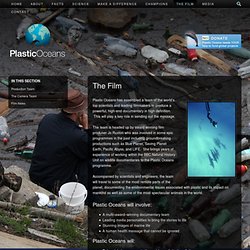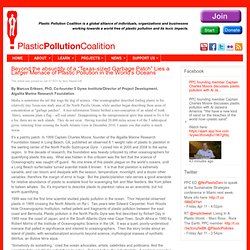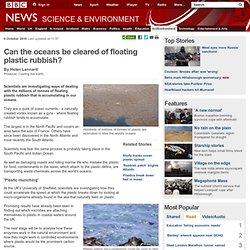

No straw, please. Embrace sustainability. Charles Moore: Sailing the Great Pacific Garbage Patch. Indian Ocean Garbage Patch. Great Pacific Garbage Patch. Chaîne de PlasticPollution. Plastico.jpg (Image JPEG, 2000x1299 pixels) - Redimensionnée (61%) Global Disaster Alert and Coordination System. Earth-Touch.com. Connecting scientists, journalists, and communicators. Climate Reality.
The Beginning Is Near. Profit Motive Has No Conscience. The Plastic Sea. July 24, 2006 Commentary by Paul WatsonFounder and President of Sea Shepherd Conservation Society On the beach on San Juan Island, Washington, Allison Lance walks her dogs every morning.

She carries a plastic bag in her hand to carry the bits and pieces of plastic debris she picks up. Each morning she fills the bag, but by the next morning there is always another bag to be filled. Joey Racano does the same in Huntington Beach further south in California. Plastic Oceans. Plastic Oceans has assembled a team of the world’s top scientists and leading filmmakers to produce a powerful, high-end documentary in high definition.

This will play a key role in sending out the message. The team is headed up by award winning film producer Jo Ruxton who was involved in some epic programmes in the past including groundbreaking productions such as Blue Planet, Saving Planet Earth, Pacific Abyss, and LIFE. Bag Ban Conspiracy (The BBC) by BleepingCreative. The Majestic Plastic Bag. First map of floating plastics to help save baby turtles. (Phys.org) -- A PhD student at The University of Western Australia is creating the first map to show the distribution of floating marine plastics in Australian waters, and models that chart the likely pathways of these plastics and sea turtle hatchlings.

"The early life of sea turtles occurs at the ocean's surface, where there's an increasing amount of floating plastics that are proving fatal to hatchlings," PhD student Julia Reisser said. Ms. Reisser, who is also a CSIRO researcher, has been studying sea turtles for nine years and in 2010 she broadened her research to include marine plastics. "My work is identifying the places contributing most to the increase in plastics in Australia's oceans and how this links to sea turtle life cycles," Ms. Reisser said. "We're quantifying plastic pollution hazards and its distribution throughout Australia's oceans, and contribute to a national marine debris audit being undertaken by CSIRO's Wealth from Oceans National Research Flagship. " Beyond the absurdity of a “Texas-sized Garbage Patch” Lies a Larger Menace of Plastic Pollution in the World’s Oceans.
By Marcus Eriksen, PhD, Co-founder 5 Gyres Institute/Director of Project Development, Algalita Marine Research Foundation Media is sometimes the tail that wags the dog of science.

One oceanographer described finding plastic in his relatively tiny Texas-size study area of the North Pacific Ocean, while another began describing these areas of concentration as “garbage patches”. A mis-information frenzie birthed a mis-conception of an island of trash. Hurry, someone plant a flag – sell real estate! Disappointing to the entrepreneurial spirit that aimed to fix it for a fee, there are no such islands. It’s a patchy patch. Can the oceans be cleared of floating plastic rubbish? 6 October 2010Last updated at 11:57 By Helen Lennard Producer, Costing the Earth Hundreds of millions of tonnes of plastic are estimated to litter the world's oceans Scientists are investigating ways of dealing with the millions of tonnes of floating plastic rubbish that is accumulating in our oceans.

They are a quirk of ocean currents - a naturally created vortex known as a gyre - where floating rubbish tends to accumulate. The largest is in the North Pacific and covers an area twice the size of France. Others have since been discovered in the North Atlantic and most recently the South Atlantic. Scientists now fear the same process is probably taking place in the South Pacific and Indian Ocean. As well as damaging coasts and killing marine life who mistake the plastic for food, contaminants in the water, which attach to the plastic debris, are transporting waste chemicals across the world's oceans.
Plasticized the Movie - Trailer. Bag It The Movie: Is Your Life Too Plastic? Plastic bags. Fight For Your World, Not Your Country. Lady Landfill Skyscraper. Honorable Mention 2011 Skyscraper Competition Milorad Vidojević, Jelena Pucarević, Milica Pihler Serbia.

Appropedia. Gaia. Seabirds study shows plastic pollution reaching surprising levels off coast of Pacific Northwest. Plastic pollution off the northwest coast of North America is reaching the level of the notoriously polluted North Sea, according to a new study led by a researcher at the University of British Columbia.

The study, published online in the journal Marine Pollution Bulletin, examined stomach contents of beached northern fulmars on the coasts of British Columbia, Canada, and the states of Washington and Oregon, U.S.A. "Like the canary in the coal mine, northern fulmars are sentinels of plastic pollution in our oceans," says Stephanie Avery-Gomm, the study's lead author and a graduate student in UBC's Department of Zoology. "Their stomach content provides a 'snapshot' sample of plastic pollution from a large area of the northern Pacific Ocean. " Northern fulmars forage exclusively at sea and retain ingested plastics for a long period of time, making them ideal indicators for marine littering. "The average adult northern fulmar weighs five pounds, or 2.25 kilograms," says Avery-Gomm.